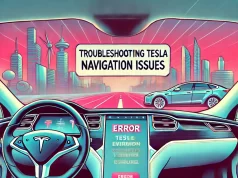If you own an electric vehicle (EV), you probably know how important it is to plan your trips and find the best charging stations along the way.
Fortunately, there are some apps that can help you with that, such as A Better Route Planner (ABRP) and Tesla Navigation.
But which one is better for your needs? In this article, we will compare these two apps based on their customization, optimization, and integration.
A Better Route Planner Vs Tesla Navigation
| Aspect | A Better Route Planner (ABRP) | Tesla Navigation |
|---|---|---|
| Supported Vehicles | Supports a wide range of EV makes and models. | Exclusive to Tesla vehicles. |
| Integration | Requires a separate app or website usage. | Plans route with Supercharger stations for Tesla vehicles. Limited customization options. |
| Real-time Data | Provides real-time data for charging stations, weather, and traffic. | Offers real-time data for Superchargers and traffic. |
| Route Planning | Offers advanced route planning for long trips, considering multiple charging stops, and customizing charging preferences. | Plans routes with Supercharger stations for Tesla vehicles. Limited customization options. |
| Charging Network | Utilizes multiple charging networks for route planning. | Primarily relies on Tesla’s Supercharger network. |
| Third-party Chargers | Allows navigation to non-Tesla charging stations. | Does not navigate to third-party charging stations. |
| Offline Maps | Limited offline map access in some cases. | Provides offline maps and navigation for Tesla vehicles. |
| User Interface | May vary based on the platform (app or website). | Tesla’s user interface is integrated into the vehicle’s touchscreen. |
| Integration with Car | This may vary based on the platform (app or website). | Fully integrated into the Tesla vehicle’s system. |
| Community Input | Allows user feedback and updates on charging stations. | Limited community input as it’s exclusive to Tesla vehicles. |
| Cost | No direct integration requires manual input. | Included with Tesla vehicles’ purchase price. |
| Accessibility | Available for various EV owners. | Exclusive to Tesla vehicle owners. |
#1. Customization: ABRP Wins
One of the main advantages of ABRP over Tesla navigation is that it is more customizable and flexible.
You can input various parameters such as your starting battery charge, extra weight, driving speed, temperature, etc. to get a more accurate estimate of your range and charging time.
You can also choose different types of chargers, such as Tesla Superchargers, CCS, CHAdeMO, etc., and filter them by cost, availability, speed, etc. This way, you can tailor your trip to your specific needs and preferences.
Tesla navigation, on the other hand, only shows you the Tesla Superchargers that are compatible with your car and does not let you adjust many settings.
It also does not account for factors such as elevation changes, wind direction, or speed limits. This may result in less accurate predictions and less optimal routes.
#2. Optimization: It Depends
Another difference between ABRP and Tesla navigation is how they optimize your trip. Tesla navigation tries to minimize the number of stops you take, while ABRP tries to minimize the total travel time.
This means that Tesla navigation may suggest longer charging stops at fewer locations, while ABRP may suggest shorter charging stops at more locations.
Depending on your preference and driving style, you may find one approach more convenient than the other. For example, if you like to take breaks often and explore different places along the way, you may prefer ABRP.
But if you want to reach your destination as fast as possible and don’t mind waiting longer at each stop, you may prefer Tesla navigation.
#3. Integration: Tesla Navigation Wins
One of the main advantages of Tesla navigation over ABRP is that it is more integrated with your car than ABRP.
You can access it from your car’s touchscreen and it will automatically update your route based on your real-time battery level, traffic conditions, weather, etc.
It also shows you the estimated arrival time and battery charge at each destination.
ABRP is a separate app that you can use on your phone or browser, and you need to manually sync it with your car’s data via a third-party service such as TeslaFi or Tronity.
This may require some extra steps and may not be as seamless as Tesla navigation. However, ABRP also has some advantages over Tesla navigation in terms of user interface and features.
For example, ABRP shows you more information on the map, such as elevation changes, speed limits, wind direction, etc.
It also lets you plan multi-stop trips, share your live location with others, and export your route to other apps such as Google Maps or Waze.
Conclusion
In conclusion, both ABRP and Tesla navigation have their pros and cons, and the best choice for you may depend on your personal preferences and needs.
You may want to try both apps and see which one works better for you. Alternatively, you can use both apps in combination to get the best of both worlds. For example, you can use ABRP to plan your trip in advance and then use Tesla navigation to follow the route in real-time.
I hope this helps you write your article. If you need more assistance or have any questions, please let me know.




